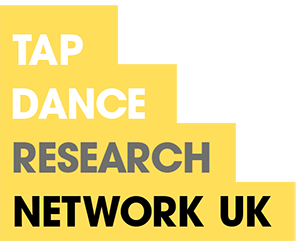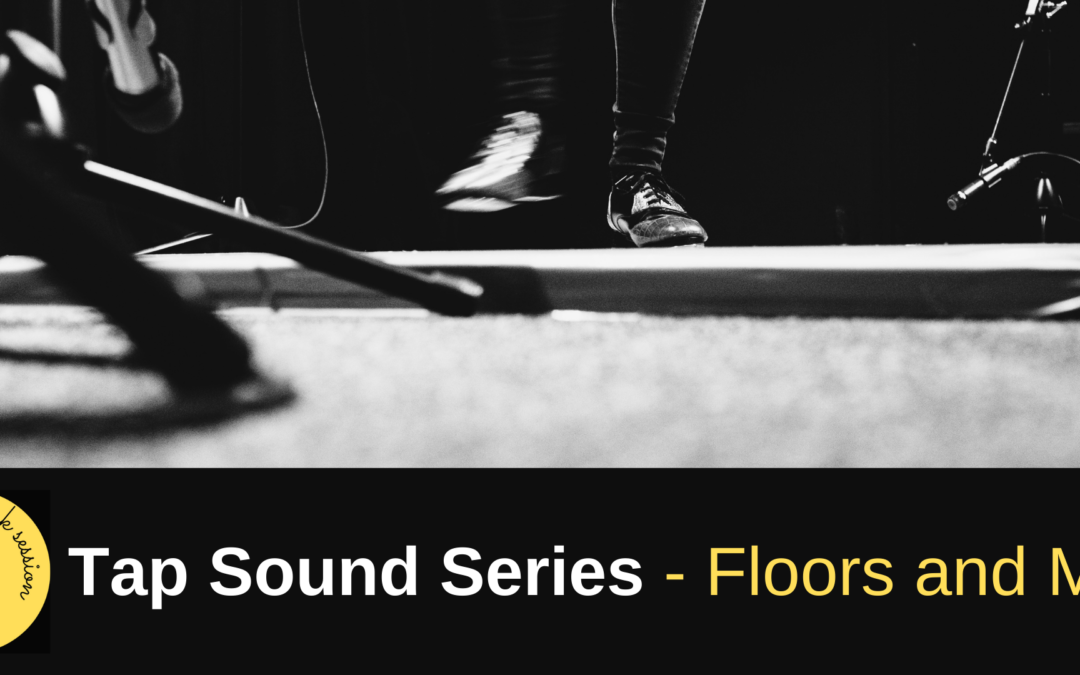
Jul 1, 2021
Thursday 8 July 19:30 BST | 11:30 PDT | 14:30 EST/EDT | 20:30 CEST
This first session of the series looked at floors and mics. Annette and Lee will talked about how to get set up with a portable tap floor and microphone for solo performance, as well as how to approach creating larger floors for group performances and mixing live sound for a tap ensemble and live music.
Lee and Annette shared their experiences of designing and building portable tap floors and working with sound engineers to achieve good quality live sound with a band. We then opened up a Q&A session followed up by conversations in breakout rooms so that we could get further into conversations about key topics.
Lee and Annette shared lots of links to help us navigate how to achieve our own performance set-up. We have shared these below. Annette also recommended this book which can be obtained through contacting One Dance UK-
A handbook for dance floors by Mark Foley
First published 1991, Dance UK
The next Network Session on August 12th will be looking at different shoes and taps. But we will be coming back to the topic of flooring and microphones in the September session from the view of larger staging and ensemble tap sound in live performance.
If you would like to contact Annette or Lee for further information or to arrange some consultancy, you can find their contact information here:
Lee Payne https://www.bruckfeetproductions.com/
Annette Walker http://annettewalker.co.uk/
Links
Floors
Annette’s blog about creating your own tap floor
http://annettewalker.co.uk/2010/02/tap-dance-flooring/
DIY Guides
https://youtu.be/K6jNEP6mYes
https://youtu.be/eUlLRud6cYg
Andrew Nemr Gig board
http://videolibrary.tapdancemethod.com/401986585?autoplay=1
Stagestep Encore floor panels. Specs are here https://www.stagestep.com/dance-floors/encore-collection/#encore-floors
Stage Step Flooring
https://uk.harlequinfloors.com/en/products/studio-equipment/harlequin-professional-home-studio-kits
Recommended foam to use under tap floors https://softfloor.co.uk/category/classic/?gclid=EAIaIQobChMIsqf4zKHU8QIVDd5RCh1PkASCEAAYASAAEgI_O_D_BwE
Annette:
My tap flooring research led me to use “closed cell foam”. Check out the tech specs of other portable sprung dance flooring systems for comparison. For my latest tap floor experiment floor (still in progress) I ordered a sheet of 10mm thick Platazote LD45 Black (https://www.poly-props.com/ld45-plastazote) 2m x 1m and cut it to the batten sizes I needed for a similar floor construction to this:
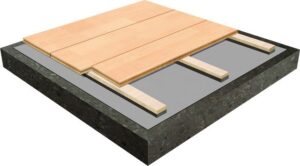
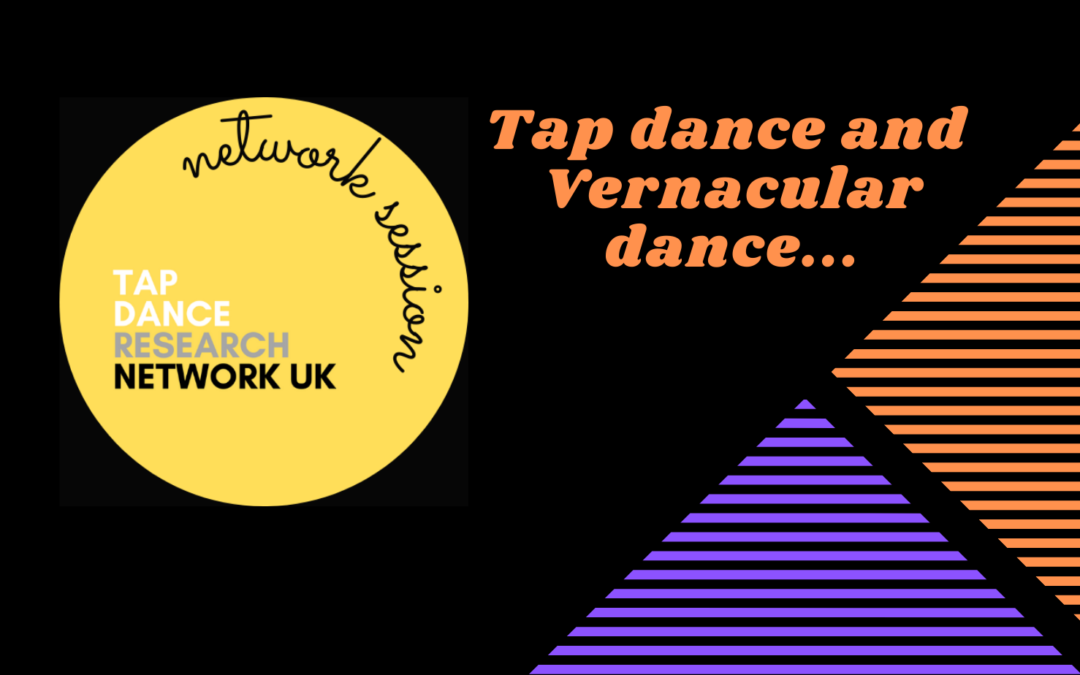
Jun 2, 2021
Following our session about tap dance and vernacular dance, this session explored what the benefits and challenges are of viewing tap dance from the perspective of ‘vernacular dance’.
We discussed the way in which scholars define ‘vernacular’ differently, focussing on different aspects depending on their area of interest. Some examples of this include:
“In describing the black vernacular tradition, which has been crucial to the story of American social dance, dance scholar Jacqui Malone sees it as “an evolving tradition and a vital process of cultural production”. She quotes Ralph Ellison…He refers to it as “a dynamic process in which the most refined styles from the past are continually merged with the play-it-by-eye-and-ear improvisations” (Malnig 2009, 4).
“Popular dance is also identified according to a specific process by which local, vernacular, and social dance traditions become popularized in the public sphere” (Malnig 2009, 5).
“In social dancing, a sense of community often derives less from preexisting groups brought together by shared social and cultural interests than from a community created as a result of the dancing” (Malnig 2009, 4).
“Crease (2000, p. 110) is consistent in his use of the term ‘vernacular dance’ which he describes as ‘the kind in which people dance amongst themselves, spontaneously, without professional training, in ordinary spaces without sharp borders between participants and spectators” (Dodds 2011, 47).
The Stearns define vernacular as “in the sense of native and homegrown” (Stearns and Stearns 1979, xvi).
“It’s hallmarks are improvisation and spontaneity, propulsive rhythm, call-and-response patterns, self-expression, elegance, and control” (Malone 1996, 2).
In groups we went on to consider our own descriptions of what vernacular dance is by contrast and comparison with ‘social dance’ and ‘popular dance’ by thinking about what is the dance like? Who dances? Why do they dance? How, the and where does the dance happen? How is the dance accessed by those who do it and those who witness it?
This discussion highlighted some key issues such as:
Who gets to decide what is ‘vernacular’, ‘popular’ and ‘social’ dance and what is the motivation for naming dance practices in this way? Is this empowering or disempowering for those that doing the dance, especially if they are doing so on a professional basis?
What are the processes by which a dance form moves from being considered ‘vernacular’ to be understood as something else such as ‘popular’, ‘commercial’ or event professional art practice?
These issues are echoed in further quotes from scholars:
“We need to do away with the labels that separate popular and so-called art culture. In the case of the Lindy and so-called modern dance, these labels serve the function of racism by separating the realms of endeavor that have traditionally been reserved for blacks— that is, vernacular or pop culture— from those that are the exclusive property of whites— namely, the world of ‘art’” (Gottschild, 2000 P215).
Dodds references dance scholar Theresa Buckland’s definition of popular dance as a “fashionable dance form: can be associated with popular music recordings. Tends to be transmitted through fashionable centres for dancing, including schools of dance, or nowadays through television. Tendency to innovation (Buckland 1983, 326)’. This brief description is part of a triadic paradigm in which the popular is set in contrast to an extended consideration of a ‘classical’ and ‘folk’ dance bianary; hence ‘the popular’ is both marginalized and defined through what it is not” (Dodds 2011, 47).
“In jazz dance, too often that missing link is African-American vernacular dance. Acknowledging the entirety of the genre allows us to establish historical, cultural, social, and kinetic continuity, which I call a continuum” (Cohen in Oliver & Guarino, 2014 P.3).
“I firmly hold to the view that pop music is not the future for jazz dance. It is important that jazz dance not limit itself to commercial trends and instead embrace its ability to generate new modes of movement invention through play and improvisation” (Wray in Oliver & Guarino, 2014 P.15).
“In black vernacular dancing, improvisation means the creative structuring, or the choreographing, of human movement in the moment of ritual performance” (Jackson 2001, 44).
“Black vernacular dance aesthetics force us to rethink dualistic Platonic- Cartesian notions and the sometimes ethnocentric divisions between improvisation and so- called set choreography” (Jackson 2001, 49).
Following this discussion, we broke into smaller groups to discuss how this topic relates to key areas of our tap dance practice; teaching, musicianship and industry contexts.
Teaching and working in educational settings – This group discussed how history, culture and musicality specific learning is largely missing in dance studio practice. The group identified a need for this to be better integrated into environments where competitions and syllabus are often the dominant approach. The group also explored the need to allow tradition to sit alongside innovation in teaching and creative work with learners.
Musicianship – This group discussed different aspects of musicianship available to tap dancers such as the tonality of the taps, and the musical role of tap dance when combined with other instruments.
Industry contexts – This group discussed the difficulties experienced by tap dance artists navigating funding and arts institutions that frame dance and music as separate disciplines. Resistance by industry ‘gatekeepers’ to accepting tap dance as being simultaneously dance, music and theatre led the group to consider the possible need to re-label tap dance in a way that reflects its roots in Africanist aesthetics.
Resources:
Dodds, S. (2011) Dancing on the Canon: Embodiments of Value in Popular Dance. Basingstoke: Palgrave Macmillan.
Gottschild, B, D. (2000) Waltzing In The Dark : African American Vaudeville and Race Politics in the Swing Era, Palgrave Macmillan,
Jackson, J “Improvisation in African-American Vernacular Dancing” Dance Research Journal, Winter, 2001, Vol. 33, No. 2, Social and Popular Dance (Winter, 2001), pp. 40-53 Published by: Congress on Research in Dance
Malnig, J. (ed.) (2009) Ballroom, Boogie, Shimmy Sham, Shake: A Social and Popular Dance Reader. Chicago: University of Illinois Press.
Malone, J. (1996) Steppin on the Blues: The Visible Rhythms of African American Dance. Chicago: The University of Illinois Press.
Stearns, M. and Stearns, J. (1968) Jazz Dance: The Story of American Vernacular Dance. New York: Da Capo.
Wells, C. (2021) Between Beats: The Jazz Tradition and Black Vernacular Dance. New York: Oxford University Press.
Wray, S. “A Twenty-First-Centry Jazz Dance Manifesto” Oliver, W & Guarino, L (2014) Jazz dance: a history of the roots and branches. Gainesville, Florida: University Press of Florida.
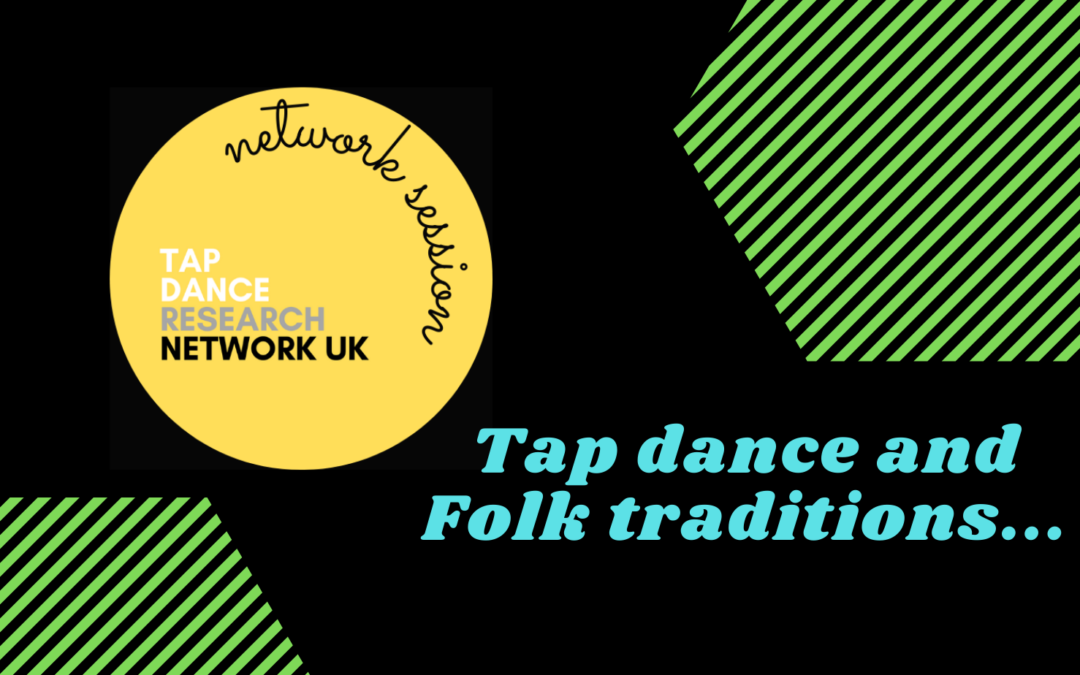
Jun 1, 2021
In this session we discussed academic approaches of studying folk traditions and folk dance, how folk traditions are approached in dance scholarship, and where tap dance fits into these topics. We started off the session with these questions to consider:
- What are opportunities, challenges, impacts of thinking about tap dance from the perspective of folk tradition?
- What makes something a Folk tradition and who decides that? Who’s tradition is it and what does that mean for how you personally engage with it?
- How does considering tap dance as a folk tradition affect the way we tap dance, educate, create, function commercially?
- What are we building our understandings of ‘folk tradition’ on and what does this need to evolve?
- What is your experience of exploring Tap Dance and Folk traditions?
Sally Crawford-Shepherd shared her experience exploring the topics during her fieldwork for her PhD, specifically during an Erasmus Exchange at Norwegian University of Science & Technology (NTNU) in 2008. She introduced the disciplines and methodologies of Dance Anthropology, Ethnography, Autoethnography, Ethnology, and Ethnochoreology. She also discussed how there are different approaches and schools of thought between American/British and European approaches to these areas of study in dance scholarship:
- American/British may focus on anthropology of human movement, meanings of movement to understand something about that society or people dancing; focus on movement systems, intentions behind the movement.
- European may focus on the folklorist approach (focus on folk traditions) or ethnology and examine how dances develop and change over time to due to cultural context.
The discussion then shifted onto how the terms ‘folk’ and ‘ethnic’ are complicated and depending on the approach taken in dance scholarship. The term ‘folk’ is often taken from the folklorist perspective and the roots of studying folk dance rely on 19th century interpretations and associations with peasant class or rural communities. The term ‘ethnic’ can constitute dance performed by a group of people living in a group/region, defined as sharing culture, or as a dance characteristic of a particular cultural group. She discussed how looking at tap dance as a folk tradition or part of folk tradition for her particular area of research into English tap jams was difficult to fully define using this European context. She also shared her experience working in Trinidad and Tobago and how exposure to folk dance and traditions there continued to raise questions about what can be defined as ‘folk’.
The discussion among the group included resources to look at for investigating approaches to folk dance and folk tradition. The conversations in the group also covered pros and cons for looking at tap dance under the lens of folk traditions and what that could mean for how we view music, rhythm, pedagogy, preserving, and innovating the art form.
Summary of discussion points – pros and cons of thinking about tap as a folk tradition and questions:
- Thinking of tap as a folk tradition allows us to connect to Black history through tap history.
- How does something become a folk tradition? Is it through the synergy of a cultural practice in a point in history eg: Jazz as the folk culture of tap. Dr. Barry Harris – ‘Jazz is the folk music of tap’.
- Considering the problematics of a term like ‘history’ and using the phrase ‘tap lore’ instead to suggest something that is rooted in the past but living in the present.
- An understanding of folk tradition that is based upon preservation can be limiting creatively, and a barrier to innovating.
- Is every dance and music form a folk tradition in some sense?
- Does ‘tradition’ imply a fixed ways of doing things or an established practice of innovation? Are these ways of thinking about tradition mutually exclusive or in practice intrinsically related?
- Can Hip Hop be considered a folk culture in the way that it brings together elements of music, visual art, movement, commentary. If so how does tap dance connect to this in its continual development?
- What are the motivations for defining something as a folk dance or folk tradition and it that intended to be empowering or disempowering for tap dance and tap dancers? Does describing something as a folk tradition distance it from recognition as an artistic practice or not?
- What are the motivations behind descriptions of dance and music practices as ‘ethnic’? In what ways is this term misused as a way of ‘othering’ people?
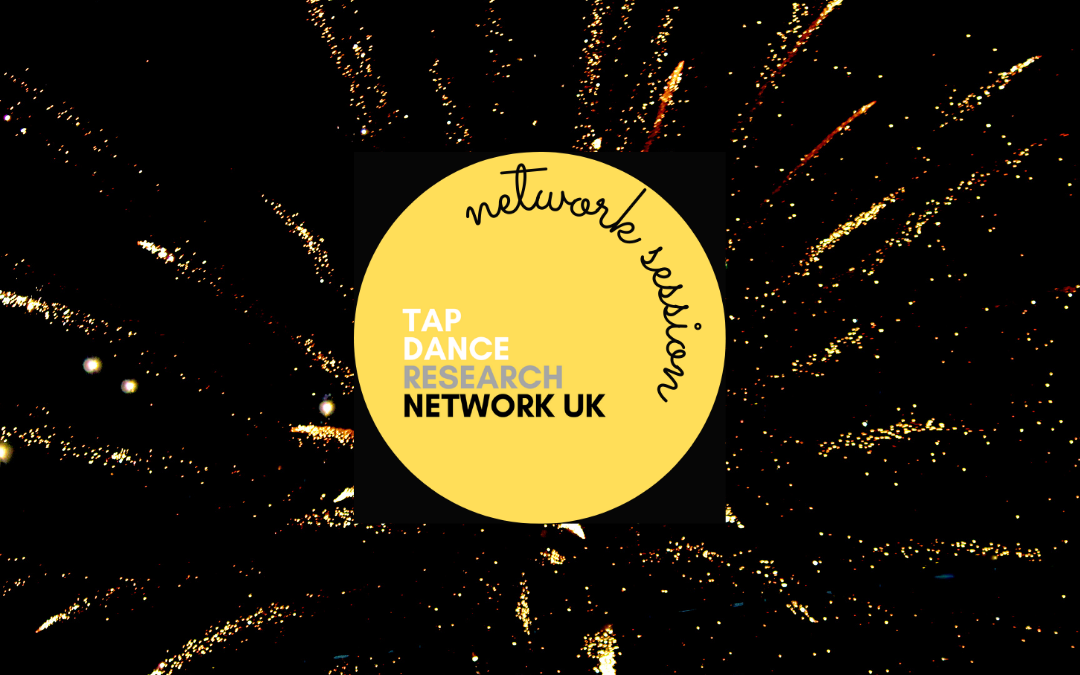
Jun 1, 2021
Our first ever TDRN UK Network Session was an opportunity for us to explore what members of the group were interested in discussing and sharing information and experiences about. Initial topics included:
- How to teach and educate learners about the histories and culture of tap dance
- Different ways of making tap dance performance work
- The life stories of tap dancers
- The history of tap dance in the UK and it’s relationship to tap dance communities in North America
- The aesthetic angle in tap dance teaching
- The ways that tap dance influences other art forms
Salon Bam led by Jess Murray: How do we reflect the culture and histories of tap dance in our research?
Jess opened up a discussion by introducing her Ph.D practice research project which looks at how ideas and themes are communicated in making dance and music collaborative improvisation-as-performance work. Jess shared questions that have arisen for her as a result of framing her own tap dance practice in a research context. This also highlights some of the tensions in the relationship between tap dance and academic institutions which need to be addressed in order to do ethical and effective research.
Jess spoke about the need to approach her research in a way that fits her own practice (improvisation, collaborative, community oriented) and is appropriate for tap dance as an art form/ cultural perspective which can often be at odds with mainstream academia. Doing ‘practice research’ which places physical experience at the centre of the learning is helpful, but other issues remain…
For example –
- As an Oral history, there are not extensive written records so other methods are needed to gather information
- Tap Dance aesthetics differ from dance and music forms that are more prevalent in academia. There is a need to develop alternative approaches that come from the perspective of tap dance rather than ‘borrowing’ from something else that ‘doesn’t fit’
- Discussion around improvisation by jazz music and Improvisation Studies scholars is useful, but at present there is very little that connects with tap dance as both dance and music.
The conversation then opened up to the group in response to the questions raised. Sally Crawford-Shepherd shared her experiences of doing an Ethnographic study of UK Tap Jams. Discussed Ethnography as a tool to create a portrait of people. Participatory observation. Story of the people.
Areas of future interest raised by the group included:
- Wooden tap shoes
- Discussion about tap dance a folk dance and other percussive folk dance forms that we are interested in such as British clog dance and Irish Sean-nós dance which is improvisatory. https://en.wikipedia.org/wiki/Sean-n%C3%B3s_dance
- We would like to know more about the early history or ‘pre-history’ of ‘tap’ dance and the experiences of those that were dancing at the time. Might there be experimental and innovative approaches to history that can reveal more in cases where certain oral history may have been lost? In addition to the oral tradition, what other ways of doing historical research through physical experience are there…?
- Considering tap dance from the perspectives of Folk tradition, Vernacular and popular culture, visual music. Thinking about ways of working with oral and embodied histories, and how this connects with written histories.
Resources mentioned in the session:
- BERLINER, Paul F. (1994) Thinking in Jazz: The Infinite Art of Improvisation. Chicago: University of Chicago Press.
- WRAY, S “Just after the pulse, rhythm takes all: the inside habitat of improvisation” in ADAIR, C and BURT, R (2017) British Dance: Black Routes. Routledge.
- WELSH-ASANTE, Kariamu ‘The “Gospel” of Memory Inscribed Bodies in the African Diaspora’ in WELSH-ASANTE, Kariamu et al (2019) Hot Feet and Social Change : African Dance and Diaspora Communities. University of Illinois Press.
- CARLOZZO, Abby ‘Embodying Rhythm Improvisation as Agency in African Dance’ in WELSH-ASANTE, Kariamu et al (2019) Hot Feet and Social Change : African Dance and Diaspora Communities. University of Illinois Press.
- HEBLE, A, CAINES, R (2014) The Improvisation Studies Reader: Spontaneous Acts. Routledge
- WILLIS, Cheryl. ‘Tap Dance: Manifestation of the African Aesthetic’ in WELSH-ASANTE, Kariamu. (1998) African Dance: An Artistic, Historical and Philosophical Inquiry Africa World Press, New Jersey
- OLIVER, W & GUARINO, L (2014) Jazz Dance: A History of the Roots and Branches. Gainesville, Florida: University Press of Florida
Travis Knight’s podcast about re-naming tap dance suggested. Tap. Love. Tour. Hosted by Travis Knights. Originally first recorded on April 3, 2015. Travis Knights’ Website Soundcloud Stitcher Apple.com
Jacobs Pillow Interactive Resources https://www.jacobspillow.org/school/
May 14, 2021
Wednesday 2 June 2021
In this session we discussed academic approaches of studying popular culture, how popular culture is approached in dance scholarship, and where tap dance fits into these topics. We started off the session with these questions to consider:
- How is tap dance portrayed in popular culture in the late 20th and 21st centuries?
- What makes something part of popular culture and who decides that?
- How can we engage in the discourse of popular culture and dance, e.g., within the jazz dance continuum or trends such as TikTok?
- What are opportunities, challenges, impacts of thinking about tap dance from the perspective of popular culture?
- How does considering tap dance as part of popular culture affect the way we tap dance, educate, create, function commercially?
Sally Crawford-Shepherd shared definitions of popular culture, such as how it is a collection of artefacts like films, music albums, and television programmes. However, popular culture often has different definitions due to individual cultures, groups, or societies having shifting values of what they perceive to be popular. She shared how popular culture is approached in academia through frameworks and theories such as The Frankfurt School, Feminist Theory, Marxism, Mass Culture studies, Mass Media, and Popular Music.
The discussion also covered how popular culture is approached in Dance Studies, and how the terms ‘social dance’, ‘vernacular dance’, and ‘popular dance’ are often used interchangeably. She shared Sherril Dodds’ work on popular dance studies, referencing how ‘[a] burgeoning interest in popular dance came to the fore in the 2001 winter edition of Dance Research Journal, which was devoted to ‘social and popular dance’. That an entire issue centred on dance practices situated outside the hallowed ground of the theatre dance canon indicated a nascent shift in dance studies towards an increasingly relativist position’ (Dodds 2011, 45). She included references for the group to explore (listed below) and another dance research group Pop Moves (popmoves.com) that shares and develops resources on popular dance research.
The discussion among the group included:
- Factors that performers and artists need to negotiate when working in the domain of popular culture. The group discussed examples where artists balance the integrity of the work and its connection to history and culture, with commercial factors which are also often needed to ensure the longevity of careers and success of the art form. We discussed the importance of key tap dance role models that exist in the domain of popular culture and the positive influences that individuals can exert when popularity is achieved with integrity.
- The role of social media and online phenomenons such as TikTok and YouTube in creating a greater presence for tap dance as popular culture. We discussed examples of tap dancers that have been successful in engaging with this and the affect it has had upon their profile and careers.
- The group discussed the numerous ways in which a practice such as tap dance can shift as it moves from being a practice within a specific community to a ‘popular’ form. This process involves not only artists and performers, but also producers, directors etc.
- The ways in which popular culture generates opportunities that are important to the continued success of a dance form. In this way, pop culture is relevant in terms of providing access to ‘gate keepers’ in the performing arts sector and industry.
Resources:
An Introduction to Theories of Popular Culture by Dominic Strinati
Cultural Theory and Popular Culture: An Introduction by John Storey
Beyond Blackface: African Americans and the Creation of American Popular Culture 1890-1930 by W. Fitzhugh Brundage
Dancing on the Canon: Embodiments of Value in Popular Dance by Sherril Dodds
Bodies of Sounds: Studies Across Popular Music and Dance by Sherril Dodds and Susan C. Cook
Ballroom, Boogie, Shimmy Sham, Shake: A Social and Popular Dance Reader Edited by Julie Malnig
The Oxford Handbook of Dance and Competition Edited by Sherril Dodds
The Oxford Handbook of Dance and the Popular Screen Edited by Melissa Blanco Borelli
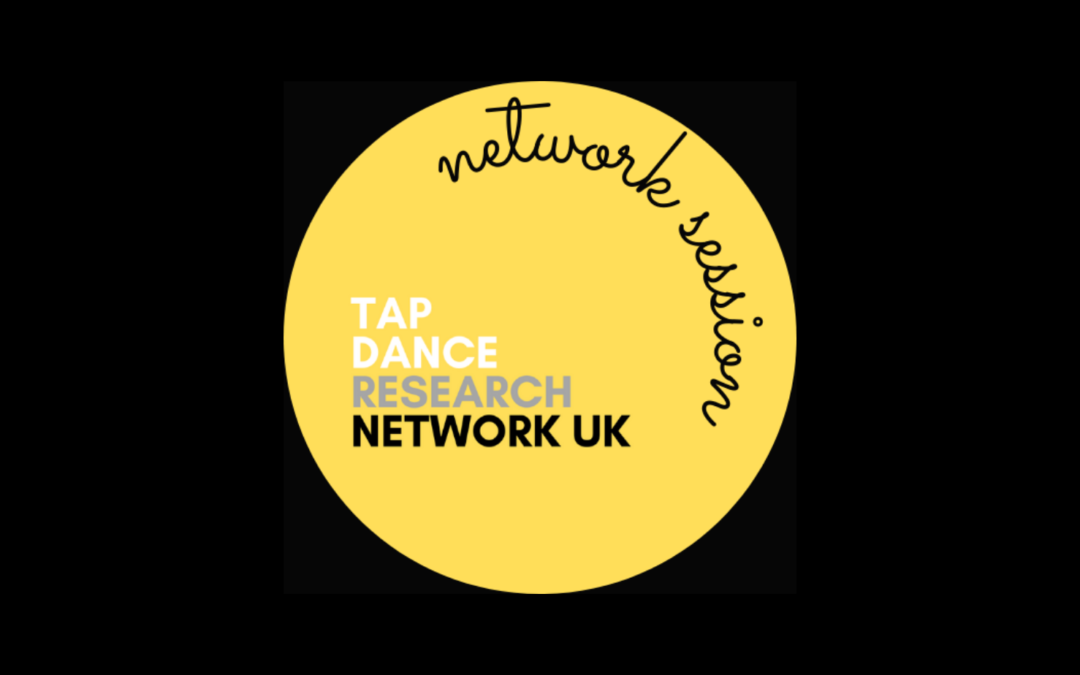
Feb 25, 2021
Members of the steering group will host these informal but structured sessions that are FREE and open to all. You can connect with other people that are interested, or involved in doing research around tap dance.
Hear from researchers and practitioners about what they are working on and have learned through their projects. Learn about different approaches to learning in the field and pick up valuable tips and insights to help you pursue your own tap dance learning. A great opportunity to ask questions, swap tips for researching and developing projects, share information about resources and opportunities.
The next few sessions will explore what happens when we consider tap dance from certain perspectives such as Folk tradition, vernacular and pop culture, visual music… What does each of these viewpoints offer and what is the relationship between them?
**Next Session**
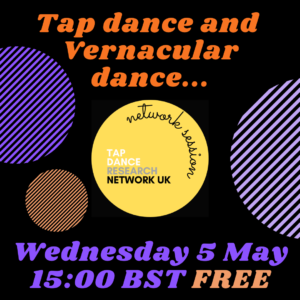
15:00 BST | 10:00 ET | 16:00 CEST
Following on from our last session that explored what happens when we consider tap dance from the perspective of Folk tradition, we now continue the journey through vernacular dance, pop culture, and social dance.
We will discuss how tap dance relates to these ideas before taking a deeper dive into vernacular dance. We will ask how appreciating tap dance as vernacular dance informs the way we dance, learn, educate, promote, discuss and research in tap dance…
Jess Murray will introduce the topic before opening it up to a conversation where different perspectives and experiences can be shared.
Book a FREE ticket
Facebook event

